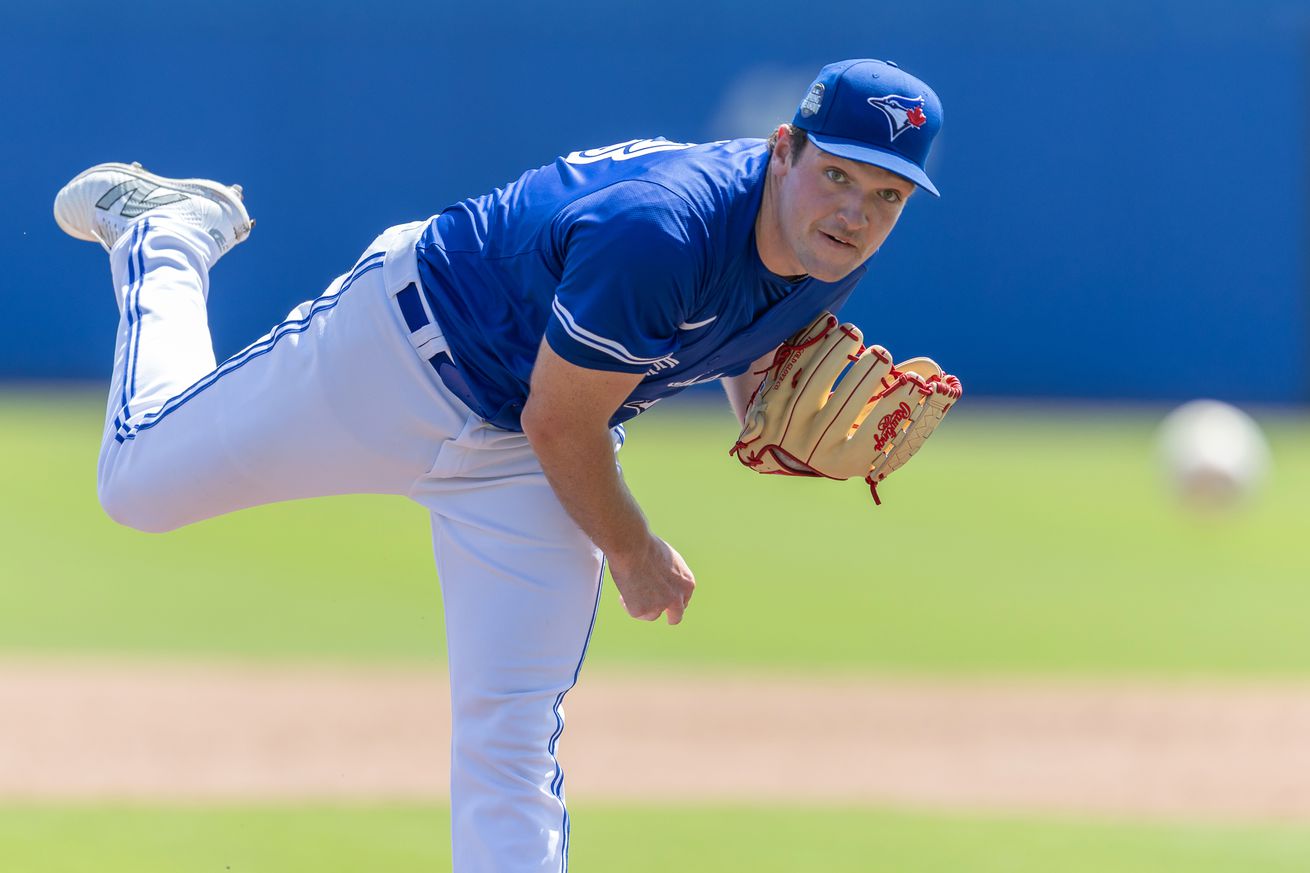
I cover the whole system in this column, but typically I like to edge towards the sleeper side of the farm most of the time. If you’re the kind of person who cares to read this, I figure you already know that Arjun Nimmala is cool, but new info on Gage Stanifer might come as a surprise. Today, though, I think it makes sense to do one of the big names.
Trey Yesavage, last year’s first round pick, has begun his season at A Dunedin. Since a debut appearance in which he appeared to be working on stuff and walked six, he’s faced 51 batters and struck out 24, allowing only eight hits and two walks for an OBP against that starts with a 1. A college arm, especially one who was drafted in the first round on the strength of uncommon polish and command, should be able to just overpower teen hitters in A ball. The advantage of watching him in Dunedin, though, is that we get StatCast data. When he moves up to a more appropriate challenge with A+ Vancouver, which he’ll likely do as soon as the weather in the northwest warms up, we’ll lose that data stream until he eventually arrives in AAA Buffalo (a stretch for 2025 even if this year goes exceptionally well). So while we have it, I wanted to dig into his pitch data a little and see how the stuff is looking.
As we wrote in our Top 40 report, Yesavage’s delivery comes over the top with a short arm action. His pitches come out 7.08 feet off the ground on average, which is higher than any pitcher in the majors this season (about 3⁄4 of an inch higher than leaders Pete Fairbanks or Justin Verlander and over 15 inches higher than the median). That creates a serious downhill plane to the plate, which is a little unfashionable right now because flatter angles pair better with the riding four seamers that are currently dominant. Because of how short his arm action is, as well as the tallness of his delivery, he also has below average extension that takes about two thirds of an mph off the perceived velocity of his pitches. There’s always value in giving hitters an uncommon look, though, and right now they don’t see a lot of balls that bear down on them in the way Yesavage’s do.
One positive thing the delivery does is allow him to get nearly pure backspin on his fastball, which he’s thrown 94 times among 198 pitches in his most recent three outings. The pitch generates an elite 19.9 inches of induced vertical break, which is about 4” more than the typical fastball thrown equally hard in the majors (he averages 94.7mph). It’s relatively straight, with 5.3 inches of arm side run, but with his kind of vertical movement that isn’t a problem. Overall the fastball profiles as a plus pitch that should be able to miss bats and generate pop ups up in the zone.
His second most used pitch is a split change that comes in 9.8mph slower, with a foot less ride and six inches more arm side run. It’s generated 16 swings and missed on 53 pitches and been watched for a strike 9 times, while hitters have made contact only 7 times for a ludicrous 30% contact rate. Four have been hit into play, all ground outs. To me it looks like another plus pitch, although his command of it isn’t quite as sharp as the fastball. The release point is very similar to the fastball, creating the deception you want from a change, but the movement and velocity are both radically different in a way that’s clearly had low level hitters’ head spinning.
Third, he throws a hard breaking ball at 87.3mph that StatCast calls a cutter but that I think scouts have typically called a slider. It looks most like a cutter in terms of shape, with little horizontal break (it actually averages 2.3 inches of arm side run, the opposite of a typical slider), but 7.4mph off the fastball is bigger than average separation and looks more like a harder slider. Regardless of what it is, he’s able to locate it up and down the arm side of the plate, and it’s been effective for him with 11 swinging strikes on 41 pitches. Nothing about the movement jumps out (though it’s not really supposed to for a cutter), but I think the combo of separation off his fastball and ability to locate will continue to let it be an effective weapon.
Finally, he will occasionally show a slower breaking ball around 83.5mph. StatCast typically calls it a slider, but it’s usually described by scouts as a curve. He’s only thrown nine all season, and it doesn’t look great, with slight arm side run (again, unusual for a breaking ball but not unheard of for a pitcher whose attack is as vertical as Yesavage’s is). It has just barely negative induced break, and its spin rate of 2,325rpm is well below average, which suggests he doesn’t have a great natural aptitude for spinning true breakers. Without a redesign, it’s a distant fourth pitch that probably works best as a surprise change of pace.
Overall, the StatCast data so far is promising. Yesavage is sitting nearer to the top of the 93-95 velocity band he inhabited in college, and his three main pitches all look at least as good as expected. It’s a little bit of an unusual look, but the pieces fit together well and the as-advertised command (again, excluding an odd first outing) brings it all together into a potent package. He should get the chance to deploy it against hitters who are a little closer to his level soon.